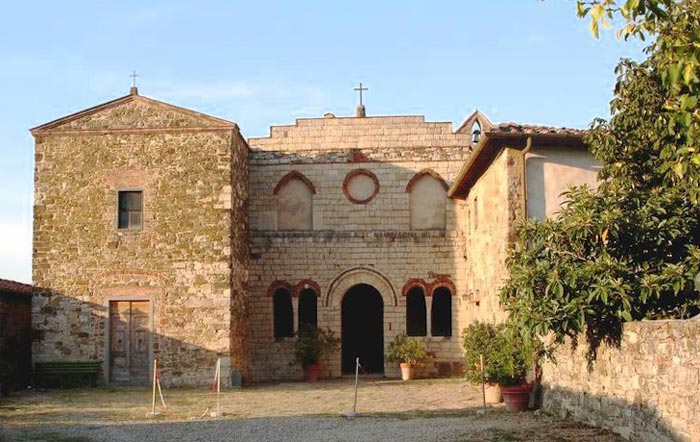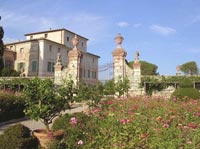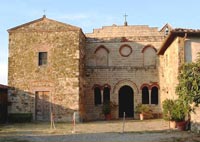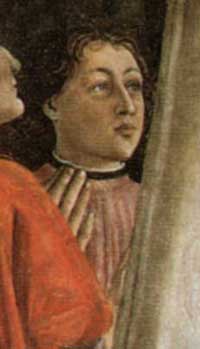 |
Pieve di San Cresci |
Greve in Chianti
|
From the first decades of the 11th century until after the mid 13th century, most of the religious buildings throughout the Chianti region were rebuilt in Romanesque style. It was a clear demonstration of the increasing prosperity and of the profound spirituality which characterized the new rural society. |
||
|
||
| Montefioralle |
||
| Castello di Montefioralle is probably one of the most ancient villages in Chianti and is still today enclosed within its original walls. The walls were octagonal in outline, with four gates. During the Middle Ages it was one of the largest military and administrative centres of the area. It belonged to the families Ricasoli, Benci, Gherardini and Vespucci. The Castle of Montefioralle was built in an undetermined period, it had two lines of walls with a lot of towers which were surrounded by the houses. The castle is octagonal in shape with four gates, a cellar, warehouses and tunnels which led to secret places. A walk among the tiny stone houses with vases at their windows is an authentic plunge into the Middle Ages. The only road, with its dean paving climbs up to the summit of the hillock, and then returns to the starting point At the highest point of the village, the Chiesa di Santo Stefano, a building with a single nave that conserves one of the richest and most valuable artistic patrimonies in the area: a I3th-century panel of the Madonna and Child by an anonymous Florentine artist, among the best conserved in existence, a representation on a panel of the Holy Trinity, a 15th-century work attributed to Neri di Bicci, and a late I4th-century Annunciation of the Florentine school, perhaps by the same artist who painted the Straus Madonna and to whom the lovely polytych of the Madonna and Saints conserved in the Church of the Sacred Heart in Greti is also attributed. The Roman Pieve di San Cresci was built in the XII century and stands outside the walls. The church is dedicated to S.Crescenzio and it has only a nave. Although the original Romanesque building has been altered in later times, the portico and the narthex are still preserved behind the facade with its central doorway flanked by two mullioned windows. The presbytery in the interior of the church is supported by four pillars and six semi-pillars. The Castello di colognole has undergone various restorations over the centuries which have highlighted its architectural features. The castle has a dominating position in front of Montefioralle Castle. From Montefioralle, there is an interesting hike along the back roads to Panzano. |
 Montefioralle |
|
| Panzano |
||
| Panzano is located at the highest point and almost exactly midway along the scenic Chiantigiana road from Florence to Siena. Parts of the original castle remain, incorporated into the church and also as an independent tower. Panzano is surrounded by prize-winning vineyards, including il Molino di Grace. Panzano's churches are definitely worth a visit: the Church of Santa Maria Assunta, which stands next to the castle, was completely rebuilt in the 19 C on the site of an ancient church, but it possesses a small 14 C Siennese Madonna and Child attributed to Botticini. In the oratory through the little door to the right of the nave is an Annunciation attributed to Michele di Ridolfo del Ghirlandaio. |
||
| The Pieve di San Leolino, in the neighbourhood of the frazione of Panzano, is probably of 8 C origin and was completely rebuilt in the 12 C in Romanesque style. The interior houses a 13th century panel by Meliore di Jacopo, a 15th century polyptych by the so called Master of Panzano, as well as works by Raffaellino del Garbo and Giovanni della Robbia.
Perched on a hill to the south of the small town of Panzano and overlooking the Pesa Valley, the parish church of San Leolino (11th century) ranks among the maximum expressions of Romanesque architecture in Chianti. That is especially true of the interior, which is perfectly preserved. It was restored in 1942 to its original Romanesque appearance with regular courses of limestone. The church is laid out on the basilica pattern with a nave and two side aisles covered by a lean-to wooden roof. The nave is separated from the aisles by six archways on either side supported by simple pilasters with cornices tapered only on the side exposed at the crossing. An interesting example of sculpture of the high Middle Ages is preserved in the church. It is a rectangular block of standstone (restored), decorated with typical motifs of the period in low relief. It is now used as a support for the table of the altar. The stone, which displays a cross embellished with a ribbon and surrounded by circles and swirls, is compatible with a chronology of the 8th century. The stone was mistakenly identified in the past as an element from a building, owned by a commoner, that preceded the construction of the church of San Leolino. The recent discovery of two tiles of the same period during restoration of the nearby oratory of Sant’Eufrosino, an attractive structure in the valley below, has encouraged hypotheses that the San Leolino panel came from an enclosure of the high Middle Ages in the oratory (source: Eurochianti – Arte Romanica tra Italia, Francia e Spagna). |
 |
|
| Badia a Passignano |
||
| Badia a Passignano is an imposing religious complex which was founded in the 11th century, at the times of the Longobards invasions in Italy, on an isolated site reachable via a branch of the road known in mediaeval times as the strada senese del Sambuco, the route to Siena preferred by the Florentines until at least the year 1200. The original abbey a Passignano was built in central Chianti near Panzano by Sichelmo in 890, in the shadow of the powerful Lombard castle of Passignano (whose central tower is still there). In 1049 it became a daughter house of Vallombrosa - the reformist Benedictine monastery and monastic order set up in the mountains to the East of Florence by Giovanni Gualberto (who lies buried in the abbey of Badia in Passignano). The Abbey takes the form of a quadrangular fortified monastic complex with corner towers. The Abbey flourished through the Middle Ages, but today, outside of the medieval tower, not much of the external building that you see is original. The abbey was suppressed, privatised, "restored" and crenulated in the nineteen hundreds, though more recently, the Vallombrosian returned to the Abbey in 1986, after 120 years of secularization of the ancient religious site. |
 Passignano |
|
| San Polo |
||
| The Pieve di San Miniato di Robbiana (11th-12th century) is located near San Polo in the northern part of the Chianti zone. The structure is divided into a nave and two aisles separated by three unequal spans sustained by squared pilasters but at the presbytery the three parts become a single hall. The building shows the modifications made in the early 19th century, which include the false dome and various internal furnishings. The remodeling in the neo Romanesque style of the early 20th century is also apparent in the bell tower and most of the facade. Externally, the original Romanesque walls of sandstone courses are visible on the right side of the church and, above all, in the semicircular apse. Romanesque windows, now sealed up, are exposed in the upper walls of the nave (source: Eurochianti – Arte Romanica tra Italia, Francia e Spagna). |
||
| Castello di Uzzano |
||
| The Castello di Uzzano (Castle of Uzzano) is a fine Renaissance villa located on the outskirts of Greve in Chianti. The villa has a double-columned façade of white plaster and pietra serena. There are a few remains of the original rectangular mediaeval watch tower. Traces of the ancient castle may be discerned in the remains of a watch tower but the predominant form of the structure is now a large 17th century villa with an excellent italianate garden restored in the 18th century. |  Castle of Uzzano and garden Castle of Uzzano and garden |
|
| Villa di Geggiano |
||
| Villa di Geggiano or Villa Bianchi Bandinelli, a villa with a famous garden, near Castelnuovo Berardenga, home since 1527 of the Bianchi Bandinelli family and its winery. Renovated between 1780 and 1790, it forms, together with the surrounding garden, a very unusual complex, both from the historical and the landscaping point of view. In the garden, adorned with centuries-old cypresses, sculpted boxwood hedges and age-old lemon trees is the characteristic open-air theatre with two late-baroque arches surmounted by statues and idyllic setting, during the summer, of classical music concerts performed by important international musicians. Villa di Geggiano was used by Bernardo Bertolucci as the set for the party in the movie Stealing Beauty. [read more] |
 Villa di Geggiano or Villa Bianchi Bandinelli |
|
| Pieve of Sillano | ||
San Giovanni Valdarno | Masaccio`s Birthplace |
||
San Giovanni Valdarno is a town situated in the Arno valley, that the Florentine founded in 1296 in order to reinforce their defensive system and to oppose Arezzo expansionist policy. Arnolfo di Cambio designed the new town on the model of a Roman encampment, with a central square from which the two main streets branched off. Once Florence had conquered Arezzo San Giovanni Valdarno which in the meantime had become the seat of the vicariate of the Upper Arno valley, maintained its defensive role against the Viscontis and the Papal army. During the 16th century, the town experienced a period of decay, from which it recovered after two centuries thanks to the developing and modernizing policy of the Habsburg-Lorraines. |
|
|
| Amerigo Vespucci |
||
| A modest building is traditionally indicated as the house of Amerigo Vespucci. America di ser Nastagio Vespucci, born in 1454, was an explorer, navigator, merchant, astrologer, and scholar, in addition to being the only person to give his name to a continent in short, a true Renaissance man. A point of interest regarding his illustrious family: the last of the Vespucds, Amerigo Di Cesare, is buried in the graveyard of Montefioralle. "In 1875, the andent lineage of the discoverer of the New World ended," recites the epigraph surmounted by an American eagle clutching the Vespucd coat of arms. Once past the watercourse of Montefioralle, we can glimpse the fountain of La Lama: an ancient fountain, a stopping place between Greve and Montegonzi. Prominent in this journey to discover the old fountains is the spring of Ragnolo, Continuing we reach Vignamaggio with its history and examples of renaissance architecture, the beautiful formal garden, and last but not least, the precious cultivation of vines and production of wine.Then, beyond the villa of the estate, the road climbs along a route that can be dated to Roman times and which crosses the castle of Lamole.The Roman road continues, skirting the mill stream and two small springs in the vicinity of the rare houses in Casole.The ancient route follows the watercourse of the Macconcini and the medieval village of San Michele, and then climbs -with a fair amount of difficult/ -to the peak of Monte San Michele.The Barbiere and Lavatoi fountains, with lovely enamelled terracottas, rise at the foot of a refreshment and reception structure. Several recent findings have demonstrated the existence of a Roman guard post, as garrison to theVia Cassia Adriana which used to cross Monte San Michele from the Sugame Pass. From the early years of the 20th century, the building of a large iron cross on a stone base was the signal of, the invitation to, a "destination" that today can be reached on horseback, by mountain bike, and on foot. ( Municipality of Greve in Chianti ) |
|
|
|
||
|
||
| Click here to open a zoomable map of Greve in a new window |
||
| There are many walks and hikes that can be enjoyed in the vicinity of Greve. It is an easy and pleasant walk up to Montefioralle and so on a longer distance to Panzano. Alternatively, one can walk north from Montefioralle via a deep valley and olive groves to the Romanesque church of San Cresci and then down-hill by a dirt road back to Greve. |
||
| Monte San Michele Nature Park | Greve to Mount San Michele | 6 - 7 hours. |
||
| Leave your car in the car park (Greve map) in front of the "Palazzo della Torre" and the Casa del Popolo and walk uphill towards the cemetery, following the signs to San Michele. Continue past Melazzano where the asphalt road changes into a dirt track (25 mins). At the turnoff to Lucolena (one hour, 630 m), you will see a large sign indicating the direction to San Michele. At this point, take the marked footpath 00 which you follow up to the Trattoria S. Michele (880 m). This takes about two and half hours all told, and in the tourist season the restaurant is open for food and drinks. From here on it is all down hill. Follow footpath 52 through the woods (marked by red spots on the trees) for about 45 minutes and then join the road. After another 45 minutes you reach the first intersection. Turn towards Lamole (not Volpaia) and in about 10 minutes you reach another intersection. There you take the road to Panzano (not Lamole) which you reach after 40 minutes. In Panzano, you might be able to catch a SITA bus to Greve. If not, head along the main Chiantigiana highway towards Greve for about 200 m and then turn left onto a dirt road, actually the old Chiantigiana, towards "La Valle" and Vitigliano. After half an hour you meet the modern Chiantigiana again and in another 20 minutes you will be Greve. [Karin Dietz, Panzano] The views are spectacular and the flora changes as you climb up towards the summit at 880 m. |
||
| Cinque verdi terre (it) Da Sezzate al Castellaccio di Lucolena |
||
Il Palagio About 45 minutes southeast of Florence, Italy, near the town of Figline Valdarno, there’s a place called Sting’s Café. This establishment is known to only a handful of insiders; to visit, you must first snag an invitation to Sting’s Tuscan home, a 900-acre estate known as Il Palagio, where the yoga-toned musician, his producer/actor/philanthropist wife, Trudie Styler, and their family spend the end of every summer.
Podere Santa Pia Hidden secrets in the Tuscan Maremma | Podere Santa Pia |
||
 |
||
Podere Santa Pia, situated halfway between Monte Amiata and the Argentario, offers its guests a breathtaking view over the Maremma hills, up to the Tyrrhenian coast, the island Montecristo and on clear evenings een Corsica. |
||
[1] Amerigo Vespucci was an Italian explorer, financier, navigator and cartographer who first demonstrated that Brazil and the West Indies did not represent Asia's eastern outskirts as initially conjectured from Columbus' voyages, but instead constituted an entirely separate landmass hitherto unknown to Old Worlders. Colloquially referred to as the New World, this second super continent came to be termed "America", deriving its name from Americus, the Latin version of Vespucci's first name. |
||

 Pieve di San Cresci
Pieve di San Cresci
